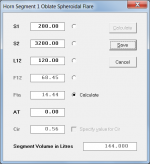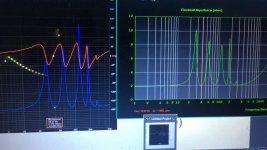sure would like to represent things in a forum without a timer for corrections.. this is annoyingly agrevatong to know end to say the least but….does a rectangle be a cyclinder matter?
Especially if a rectangle retains it to one ratio or something similar maybe oneespecially if a rectangle retains a to one ratio or something similar maybe eight to one to the cube which holds the volume of a sphere exactly at 52.36%
i dont know how to explain this but 30 degrees is also 0.5236…
thank goodness💚 the moment we stop catering to box plans the moment we go back to learning!!!The whole reason for implementing the change was to make the contents of the file easier for the user to understand - in particular the filter data. To be consistent I decided to use a heading format similar to that employed in the Help file. I had assumed that only Hornresp would be reading an exported file, so was not concerned about making it easier for a computer to understand 🙂.
Use the Horn Segment Wizard tool.How to specify the angle of an OS horn at the mouth (at the (finite) length of the horn - not at infinity (asymptotic value)?
Fta is the flare tangent angle at the mouth, AT is the horn throat entry half-angle.
Attachments
1200 (1)
300(Fb) 1/4
100 3 x 1/4
60 (5 x 1/4
42.857142
33.3333
600 (0.5)
150(2x
75(4x
50f6x
37.5
30
7.2hz(1)
28.8hz (1/4 x
86.4(3x
144(5x
192(7x
259.2(9x
316.8(11x
14.4hz(0.5x)
57.6(2x
115.2(4x
172.8(6x)
230.4(8x
288(10x
345.6(12x)
odd/even harmonics . the rest is rubbish
no coincidence 86400 seconds exist i 1440 minor 24 hr or ONE day? feed the sheep away to learn please(like it or not David you’re a bit of a shepherd my friend)
300(Fb) 1/4
100 3 x 1/4
60 (5 x 1/4
42.857142
33.3333
600 (0.5)
150(2x
75(4x
50f6x
37.5
30
7.2hz(1)
28.8hz (1/4 x
86.4(3x
144(5x
192(7x
259.2(9x
316.8(11x
14.4hz(0.5x)
57.6(2x
115.2(4x
172.8(6x)
230.4(8x
288(10x
345.6(12x)
odd/even harmonics . the rest is rubbish
no coincidence 86400 seconds exist i 1440 minor 24 hr or ONE day? feed the sheep away to learn please(like it or not David you’re a bit of a shepherd my friend)
345.6 m/sec1200 (1)
300(Fb) 1/4
100 3 x 1/4
60 (5 x 1/4
42.857142
33.3333
600 (0.5)
150(2x
75(4x
50f6x
37.5
30
7.2hz(1)
28.8hz (1/4 x
86.4(3x
144(5x
192(7x
259.2(9x
316.8(11x
14.4hz(0.5x)
57.6(2x
115.2(4x
172.8(6x)
230.4(8x
288(10x
345.6(12x)
odd/even harmonics . the rest is rubbish
no coincidence 86400 seconds exist i 1440 minor 24 hr or ONE day? feed the sheep away to learn please(like it or not David you’re a bit of a shepherd my friend)
or 346.41016 are interesting as the speed of sound for obvious reasons
That's what I am doing but the last value in the exported horn data is always less than the angle specified. I think the Fta might be the asymptotic value, not the value at the mouth.Use the Horn Segment Wizard tool.
Fta is the flare tangent angle at the mouth, AT is the horn throat entry half-angle.
The data for the angle at the mouth exists but it is cumbersome to get at (save the Horn Segment Wizard tool values, re-calculate the modified design, go to the schematic window, export the horn data, open the exported file and read the last value).
I'd be happy if pressing the calculate button in the Horn Segment Wizard tool could show the actual angle at the mouth in parentheses.
I will investigate.I'd be happy if pressing the calculate button in the Horn Segment Wizard tool could show the actual angle at the mouth in parentheses.
Funny enough, the format of INI files allows for both computers and casual readers to understand 🙂 . I think they were designed with that purpose in mind, but I could be wrong on that (it's been a while).The whole reason for implementing the change was to make the contents of the file easier for the user to understand - in particular the filter data. To be consistent I decided to use a heading format similar to that employed in the Help file. I had assumed that only Hornresp would be reading an exported file, so was not concerned about making it easier for a computer to understand 🙂.
You can for example insert comments at any point, including the same line as a keyname=value pair. All that's required is that the comment be preceded by a semicolon. If someone's using Windows' built-in routines to read a parameter from an INI file, it will ignore everything on the line from the semi-colon onwards. This way you can document the reason for every key/value pair if you wanted to.
For example this:
[Alignment]
;The following parameters define the alignment
Type=OD ; Offset Driver design, with the driver located at position S2
Ang=2.0 ;
Eg=2.83 ; Drive voltage
Rg=0.20 ; series resistance between the amplifier and the loudspeaker
S1=1224.30 ; cross-sectional area at the start of the horn (section L12)
S2=1224.30 ; cross-sectional area at the start of section L23
S3=1224.30 ; cross-sectional area at the end of section L23
S3S=210.00 ; cross-sectional area at the start of section L34
S4=210.00 ; cross-sectional area at the horn's mouth (section L34)
L12=40.90, PAR ; the length of section L12, parabolic expansion
L23=38.20, PAR ; the length of section L23, parabolic expansion
L34=39.20, PAR ; the length of section L34, parabolic expansion
Path=42.9 ; shortest distance between the driver and the mouth of the horn
You can be as wordy as you want with the comments.
when the feed back involves no sawdust and measure …will we start to see a degrade hornresponses potential .. please be careful .
Attachments
Last edited:
Didn't he kick you out from his group already for your non-scientific posturing about speaker design?when the feed back involves no sawdust and measure …will we start to see a degrade hornresponses potential .. please be careful . martin builds NOTHing except insults about you(us) all(to this day you all ‘ mentally masterbation ’) in my facebook group (i no longer tolerate it, he’s about to get the boot in a unanimous vote..)
i guess measurements aren’t ever enough.. nothing satisfies the arrogant. please don’t get distracted with reality and your ‘science’ ??Didn't he kick you out from his group already for your non-scientific posturing about speaker design?
i’m ready anytime, can you can keep up(your table saw)? not your ‘ideas’. the truth is simple right?
i build the exact thing i sim(HR) and it nails it EvERYTiMe. (unlike some of the ‘golden’ paraflex or many tapered anomalies you call mltl?
Last edited:
we have trophies in California from competitors who learned from horn response and continue to find the leader board is litered with HR users. or the same builds figured out (adapted to other TS para) using … this will reach greater numbers no doubt .. (everyone possibly )
I'm not into TL's. It's just another BR enclosure to me.some people are misrepresenting Martin King lately
its all too confusing at some point. tapering vs stepped reduction at ‘node / antinode (3 x 1/4 harmonic) certainly isn’t breaking any folding down to understand or take advantage of pi/9 in a TL does.I'm not into TL's. It's just another BR enclosure to me.
tapering is just infinite confusion( but its in all
my full range TLs
it is NOT in any subwoofer ODMLTL i’ve built since noticing the results otherwise .its fun and rewarding when predictable results are consistent tool
Currently, for an Obl type system Fta is the coverage half-angle. In the next update the coverage half-angle will be designated as CA in the Horn Segment Wizard and Fta will become the flare tangent angle at the horn mouth.I think the Fta might be the asymptotic value, not the value at the mouth.
I was not aware that there was a generally-accepted standard INI format. Apart from enclosing the section headers in square brackets, what other changes would need to be made to the current Hornresp export file format to comply with the INI format? Are blank lines permitted, can there be a space on each side of the delimiting equals sign, and can keynames be multiple words separated by spaces? These are all things I see as desirable.Funny enough, the format of INI files allows for both computers and casual readers to understand 🙂 .
Blank lines are permitted.
Leading and trailing spaces around the "=" sign should be ignored.
I suspect that keynames can't be multiple words separated by spaces. The keyname/value pairs typically represent variables in use in the program, and variables typically don't have spaces in their names.
See link for further information on the INI format - https://en.wikipedia.org/wiki/INI_file
Leading and trailing spaces around the "=" sign should be ignored.
I suspect that keynames can't be multiple words separated by spaces. The keyname/value pairs typically represent variables in use in the program, and variables typically don't have spaces in their names.
See link for further information on the INI format - https://en.wikipedia.org/wiki/INI_file
And the HOQWSDidn't he kick you out from his group already for your non-scientific posturing about speaker design?
Oh, he's still a member there. He was just asked to open his own group for sharing his non-scientific "theories"...And the HOQWS
My curiosity got the better of me - I couldn't resist sending an email to Martin asking him why he changed methods 🙂. I found his reply to be very informative and interesting, and he has kindly given me permission to share it with everyone here.Wonder why he did this since of the various combinations I simmed from his original produces excellent designs.
As a result of Martin's reply and for the sake of completeness I am now thinking of adding other Vance Dickason tables to Method MK 2021, and allowing the user to choose which table they want.
////////////////////////////////////////////////////////////////////////////
"The older alignment tables tended to produce a very large enclosure compared to a bass reflex design, they lived along a very narrow design curve. The newer alignment tables produce an enclosure that is the same size as the equivalent BR enclosure designed from the LDC alignment tables, this to me is a big advantage. Also using the LDC BR alignment tables a lot more potential geometries are available that produce different enclosure volumes by accounting for different alignments (BB4, SC4, and QB3) as well as different amounts of box losses QL. I also found for the larger enclosures designed using the original alignment tables that when you start adding fiber stuffing the results tend to move towards the smaller LDC BR alignment table results with the same stuffing density so there was no real advantage to the larger enclosure.
The two sets of alignment tables (2006 and 2021) can both be used to design a TL enclosure, but I much prefer the newer method."
////////////////////////////////////////////////////////////////////////////
- Home
- Loudspeakers
- Subwoofers
- Hornresp

